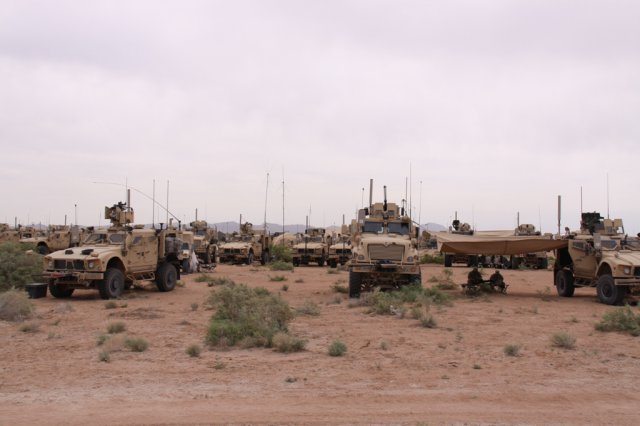As the Army’s third Network Integration Evaluation concludes, the service in the midst of synchronized fielding efforts as it prepares to field the first integrated group of advanced tactical communications technologies to deploying Soldiers beginning this October.
This group of networked technologies, known as Capability Set 13, is composed of network components, associated equipment and software that will for the first time deliver an integrated voice and data capability throughout the entire Brigade Combat Team, or BCT, formation, from the brigade commander to the tactical edge – the dismounted Soldier.
The five-week Network Integration Evaluation, known as NIE 12.2, validated the connectivity, architecture and components of Capability Set 13, the tactical network baseline that will extend the network down to the individual Soldier and significantly enhance Mission Command On The Move and Soldier connectivity.
The NIE is a key enabler of the Army’s new Agile Acquisition Process aimed at rapidly developing, acquiring and fielding integrated mission command capabilities. This process allows the Army to assess capability gaps, rapidly form requirements, solicit mature industry solutions and perform laboratory and field evaluations – shortening years off the traditional acquisition timeline.
The Army’s Capability Set fielding plan supports a synchronized vehicle and network fielding strategy, prioritizes capabilities for our deployed forces, and improves alignment of limited resources.
Beginning in October, the Army will begin to field Capability Set 13 to up to eight BCTs with priority going to deployed forces (three BCTs), units scheduled to deploy next (three BCT training sets), a forward stationed brigade in Korea, and the 2nd Heavy Brigade Combat Team, 1st Armored Division.
Key to this effort is bringing the Army’s Program Executive Offices, or (PEOs, and Program Managers, known as PMs, together during the NIE/Agile Process using the Capability Set Integrated Master Schedule, or IMS, for integration, production and deployment. The IMS is the backbone of Capability Set 13 as it serves to synchronize the network and vehicle PMs’ master schedules as they relate to integrating and fielding capability sets.
On May 1, the Army completed the mine-resistant, ambush-protected, or MRAP, final design review, which solidified how Capability Set 13 assets will be integrated into that vehicle platform. MRAPs will be utilized in the first Infantry Brigade Combat team formations that will be equipped with Capability Set 13.
The NIE has been vital to validating MRAP network design and architecture. Soldier feedback out of the NIE process has lead to many design and user interface improvements that are currently being incorporated into the final MRAP configuration. Under the current construct, networked Humvee platforms will be used as training sets by continental U.S., or CONUS, units as they prepare to deploy. Working with Army Research and Development Centers and industry, Capability Set fielding teams have nearly completed the Humvee preliminary design review.
Today, final engineering drawings for the first five “super configuration” MRAP prototype vehicles are being finalized at the U.S. Army Tank Automotive Research, Development and Engineering Center, or TARDEC, located in Warren, Mich.
“We are beginning to build and test the Capability Set 13 prototypes, which is an astronomical feat given that we started the production design only six months ago,” said Elizabeth Miller, chief engineer, synchronized fielding, System of Systems Integration (SoSI) Directorate.
The remaining prototype vehicles to be equipped with Capability Set 13 will be built at the Space and Naval Warfare Systems Command, or SPAWAR, in Charleston, S.C., and the Red River Army Depot in Texarkana, Texas. SPAWAR will build the MRAP production assets to support the October fielding of Capability Set 13, while Humvee training set production will be done at Red River.
These vehicles will be used to support safety release testing and network verification testing, both performed at Aberdeen Proving Ground, Md.
As vehicle and system design and integration plans are finalized, equipping meetings with receiving units have swung into high gear. The first units to receive Capability Set 13 will be two brigades in the 10th Mountain Division. Recently, several key Army commands and staff offices including U.S. Army Forces Command, Army Materiel Command, G-3/5/7 and G-8, SoSI and several PEOs attended a three-day Capability Set 13 Unit Equipping and Reuse Conference with the 10th Mountain Division in order to develop, synchronize and schedule all Capability Set 13 new equipment training and fielding requirements aligned with the receiving brigade’s training schedule.
New equipment training will begin with 10th Mountain Division units in October.
“We are very excited about the great integrated capability that we will soon field to our brigade and Soldiers,” said Lt. Col. Darby McNulty, SoSI. “The Agile Process and three consecutive NIEs have built a very solid team across dozens of Army organizations. We are taking lessons learned from the NIEs and directly applying those to fielding CS 13 to the 10th Mountain and other units.”
Following the fielding of Capability Set 13, the Army will program to field up to six BCT sets of network equipment per year for the fiscal year 14-18 Program Objective Memorandum in order to better synchronize its platform and network modernization efforts.










